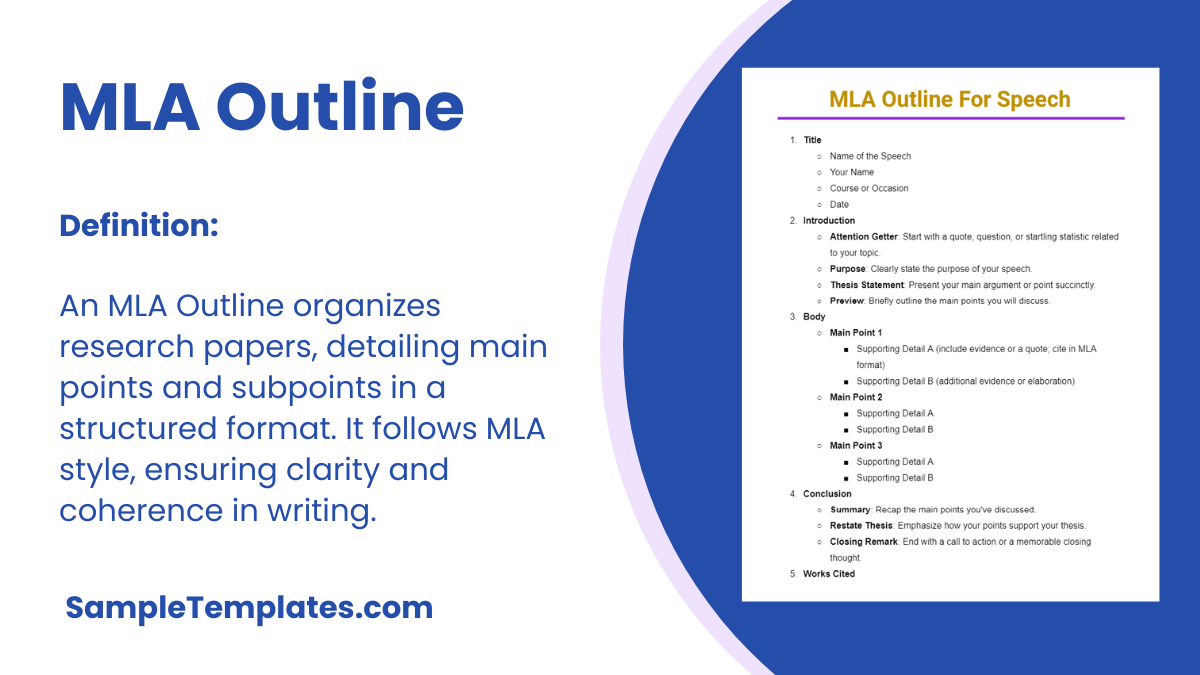Academic Writing is writing used in academic essays, thesis, academic assignments and all other academic work. The outline template for essay is widely used by academic writers to do such assignments. Academic writing has to have a specific format. The MLA research paper outline template is one of the widely used formats to be used in academic writing. There are others too. The MLA research paper template is designed to make it easy for writers to complete assignments in the MLA format. MLA is an abbreviation for the Modern Language Association format. You may check business plan outline templates.
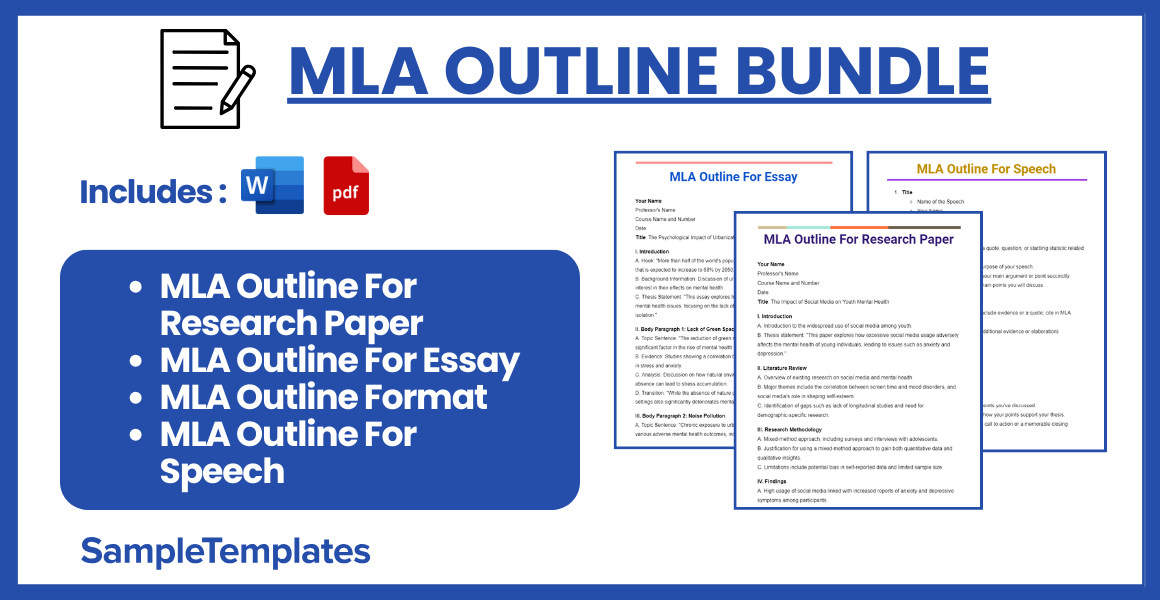
MLA Outline For Research Paper
Your Name
Professor’s Name
Course Name and Number
Date
Title: The Impact of Social Media on Youth Mental Health
I. Introduction
A. Introduction to the widespread use of social media among youth.
B. Thesis statement: “This paper explores how excessive social media usage adversely affects the mental health of young individuals, leading to issues such as anxiety and depression.”
II. Literature Review
A. Overview of existing research on social media and mental health.
B. Major themes include the correlation between screen time and mood disorders, and social media’s role in shaping self-esteem.
C. Identification of gaps such as lack of longitudinal studies and need for demographic-specific research.
III. Research Methodology
A. Mixed-method approach, including surveys and interviews with adolescents.
B. Justification for using a mixed-method approach to gain both quantitative data and qualitative insights.
C. Limitations include potential bias in self-reported data and limited sample size.
IV. Findings
A. High usage of social media linked with increased reports of anxiety and depressive symptoms among participants.
B. Findings support the thesis by illustrating a clear statistical correlation between time spent on social platforms and reported mental health issues.
C. Contrasts with some earlier studies that did not find a significant impact on mental health.
V. Analysis and Discussion
A. Analysis of how social media can lead to social comparison, impacting self-esteem and anxiety.
B. Broader implications for parental control and educational policies on media literacy.
C. Suggests areas for future research including longitudinal studies to observe long-term effects.
VI. Conclusion
A. Recapitulation of the research findings emphasizing the negative impacts of social media.
B. Restatement of the thesis, reinforcing the link between social media use and mental health deterioration.
C. Closing remarks on the need for increased awareness and preventive measures.
VII. Works Cited
- Include all the sources you cited throughout your paper in MLA format.
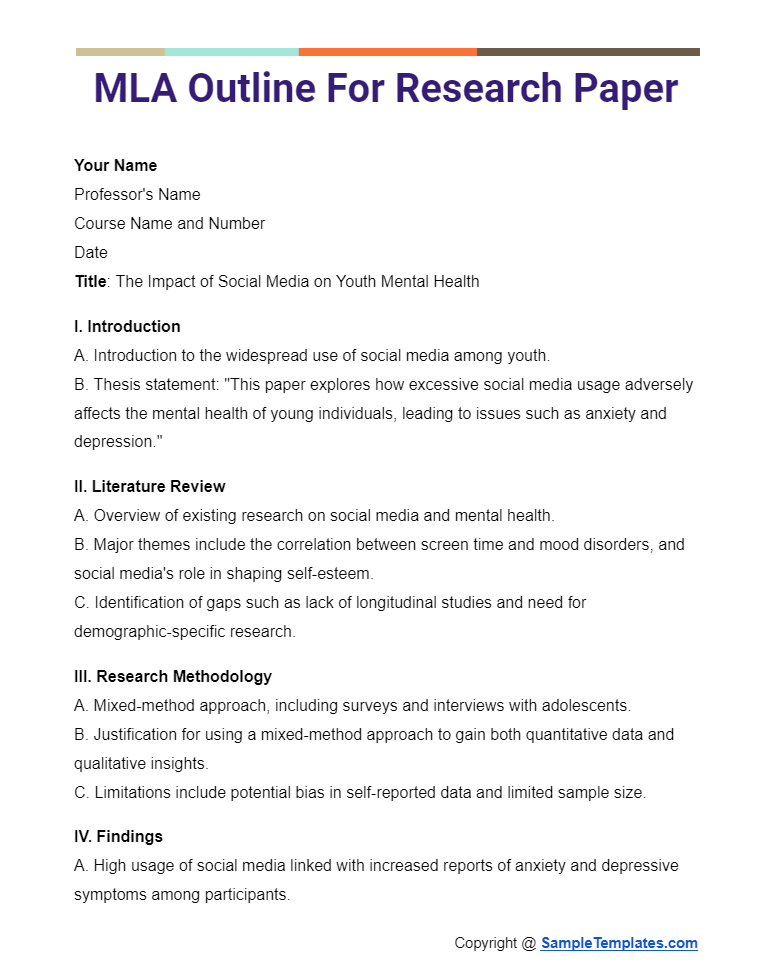
MLA Outline For Essay
Your Name
Professor’s Name
Course Name and Number
Date
Title: The Psychological Impact of Urbanization
I. Introduction
A. Hook: “More than half of the world’s population now lives in urban areas, a proportion that is expected to increase to 68% by 2050.”
B. Background Information: Discussion of urbanization trends and the growing research interest in their effects on mental health.
C. Thesis Statement: “This essay explores how urbanization contributes to increased mental health issues, focusing on the lack of green spaces, noise pollution, and social isolation.”
II. Body Paragraph 1: Lack of Green Spaces
A. Topic Sentence: “The reduction of green spaces in urban environments is a significant factor in the rise of mental health problems among city dwellers.”
B. Evidence: Studies showing a correlation between lack of green spaces and increases in stress and anxiety.
C. Analysis: Discussion on how natural environments promote relaxation and how their absence can lead to stress accumulation.
D. Transition: “While the absence of nature plays a role, the pervasive noise in urban settings also significantly deteriorates mental well-being.”
III. Body Paragraph 2: Noise Pollution
A. Topic Sentence: “Chronic exposure to urban noise pollution has been linked with various adverse mental health outcomes, including higher levels of stress and disturbed sleep.”
B. Evidence: Data from the World Health Organization on the impact of noise on urban populations.
C. Analysis: Explanation of how noise acts as a constant stressor, disrupting daily life and causing fatigue.
D. Transition: “Beyond the environmental factors, the social environment in cities can also exacerbate feelings of isolation.”
IV. Body Paragraph 3: Social Isolation
A. Topic Sentence: “Despite the high population density of urban areas, social isolation is remarkably prevalent and contributes to mental health declines.”
B. Evidence: Research findings on the paradox of ‘loneliness in crowds’ experienced in cities.
C. Analysis: Analysis of how urban lifestyles can lead to weakened community bonds and increased feelings of isolation.
D. Transition: “These factors collectively demonstrate the multifaceted impact of urbanization on mental health.”
V. Conclusion
A. Summary of Main Points: Recapitulation of how lack of green spaces, noise pollution, and social isolation each contribute to the deterioration of mental health in urban settings.
B. Restatement of Thesis: Reinforcement of the thesis that urbanization significantly affects mental health.
C. Closing Remark: Suggestion for urban planning and policy changes to mitigate these effects, fostering healthier urban environments.
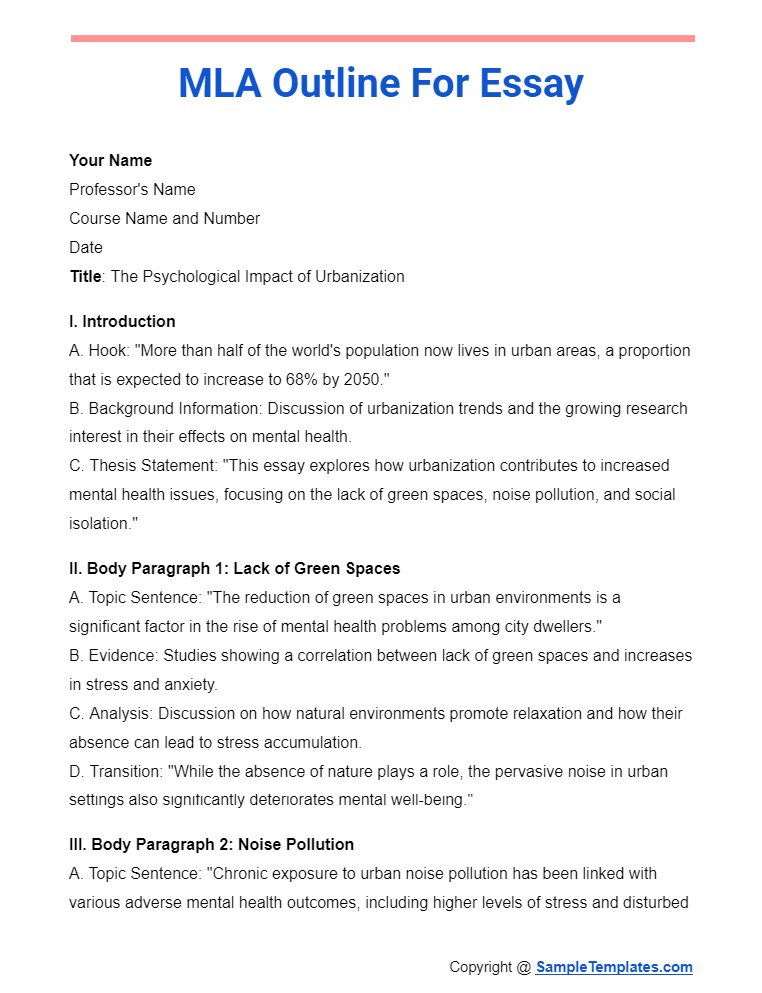
MLA Outline Format
- Title Page (optional, depending on your instructor’s requirements)
- Title of the paper
- Your name
- Course title
- Instructor’s name
- Date
- Thesis Statement
- Clearly state your paper’s main argument or hypothesis.
- Introduction
- Introduce the topic.
- Provide background information.
- Narrow down to your thesis statement.
- Body Paragraphs (Divided into various sections based on main points)
- Section Heading (if required)
- Point 1
- Supporting detail
- Example or evidence (cite sources in MLA format)
- Point 2
- Supporting detail
- Example or evidence (cite sources)
- Point 3
- Supporting detail
- Example or evidence (cite sources)
- Point 1
- Section Heading (if required)
- Counterarguments (if applicable)
- Present opposing viewpoints.
- Refute with evidence and reasoning.
- Conclusion
- Summarize the main points.
- Restate the thesis in light of the evidence presented.
- Suggest further research or implications.
- Works Cited
- List of all sources cited in the paper, formatted according to MLA guidelines.
- Appendices (if necessary)
- Any additional material (charts, maps, photos, or other documents).
Each section should start on a new page. Remember to use consistent formatting according to MLA style guidelines, such as double spacing, 1-inch margins, and a readable font like Times New Roman 12 pt. Additionally, use in-text citations wherever you reference material from your source documents
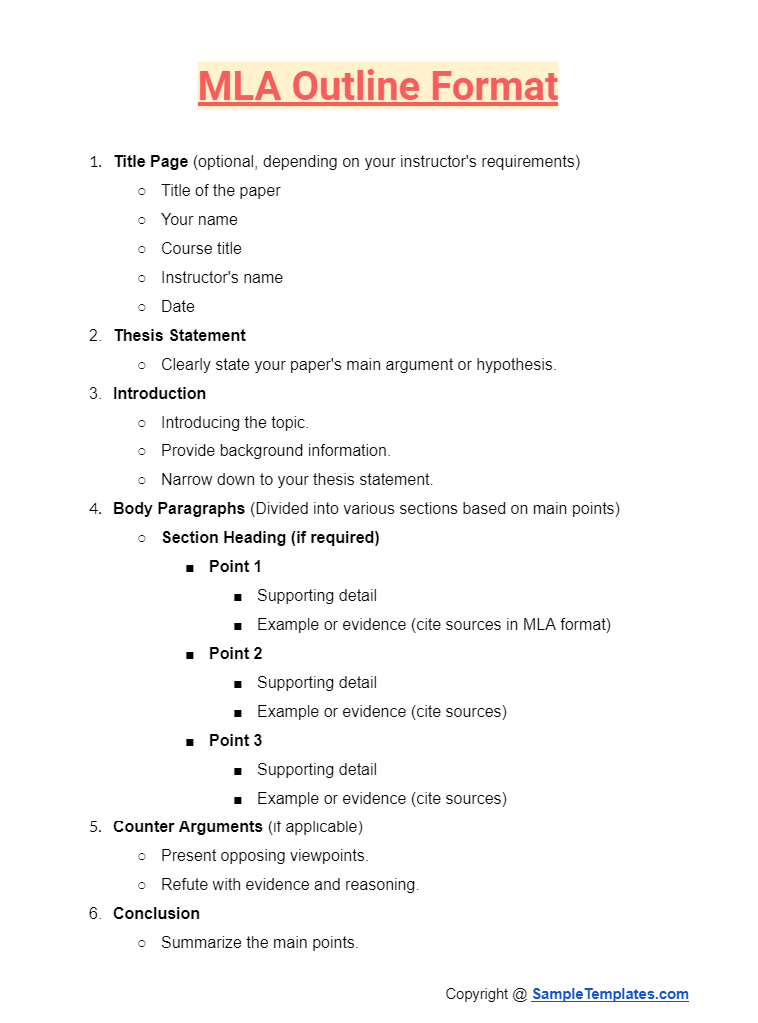
MLA Outline For Speech
- Title
- Name of the Speech
- Your Name
- Course or Occasion
- Date
- Introduction
- Attention Getter: Start with a quote, question, or startling statistic related to your topic.
- Purpose: Clearly state the purpose of your speech.
- Thesis Statement: Present your main argument or point succinctly.
- Preview: Briefly outline the main points you will discuss.
- Body
- Main Point 1
- Supporting Detail A (include evidence or a quote; cite in MLA format)
- Supporting Detail B (additional evidence or elaboration)
- Main Point 2
- Supporting Detail A
- Supporting Detail B
- Main Point 3
- Supporting Detail A
- Supporting Detail B
- Main Point 1
- Conclusion
- Summary: Recap the main points you’ve discussed.
- Restate Thesis: Emphasize how your points support your thesis.
- Closing Remark: End with a call to action or a memorable closing thought.
- Works Cited
- List all sources cited during the speech in MLA format.
This outline structure will help keep your speech organized and ensure that all critical points and supporting details are covered effectively. Each main point should advance your argument and be clearly supported by evidence. Remember to adapt the level of detail in your outline to fit the length and depth of your speech.

Browse More Templates On MLA Outline
MLA Outline Template for Free
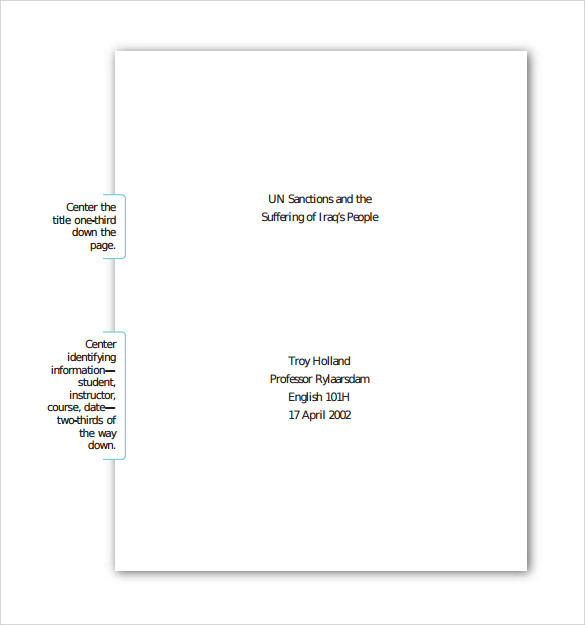
In this document, the title field in the center one third of the cover page. Additionally, the fields in the blank outline template are reserved for the writer’s name and the guide’s name are also given, but these two are two thirds of the way downwards. The course name and the date of instruction fields are also present two thirds of the way downwards.You may also see essay outline examples.
MLA Outline Levi Template
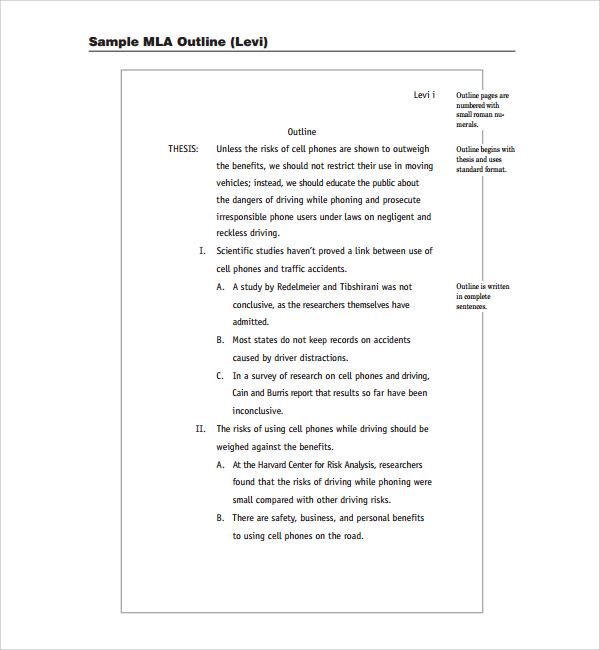
The MLA Outline Levi Template is a document that has a field for the title of the report in the center one third of the cover page. Here the student’s name field is given in the middle of the page while the course name, professor’s name and date of instruction fields are centered near the bottom of the page.You may also see story outline examples.
MLA Outline Template PDF

Using the MLA outline template for Google docs helps people get much better grades. Any research that is done has to be presented to the reader in a specific format for professors and readers to understand it. Research references, bibliographies and indexes should be so done that a reader can access them with a single flick of a button.You may also see agenda outline samples.
How to Write an Outline in MLA Format?
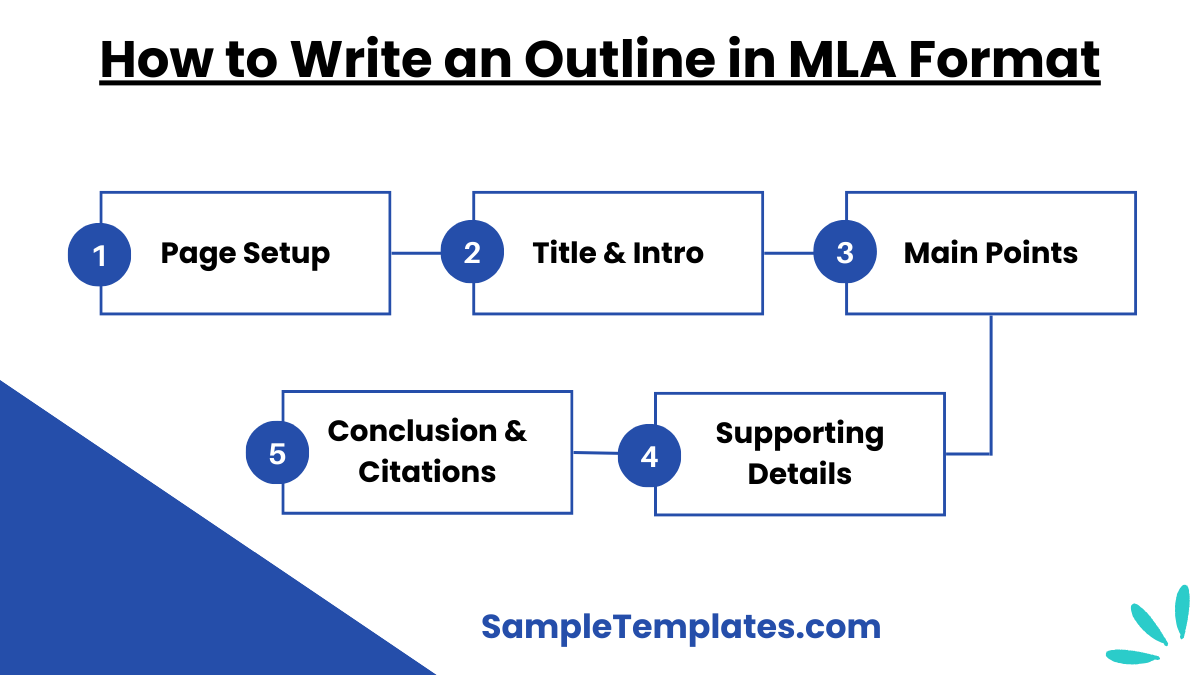
- Set Up the Page:
- Use standard letter-size paper (8.5 x 11 inches).
- Maintain 1-inch margins on all sides.
- Choose a readable font like Times New Roman in 12-point size.
- Double-space all text, including the outline.
- Title and Introduction:
- Place the title of the outline at the top center of the page.
- Under the title, write your thesis statement, which should clearly express the main argument or point of your paper. You can also see more on Research Paper Outlines.
- Structure the Main Points:
- Use Roman numerals (I, II, III, IV, etc.) to mark the main headings.
- Start each heading with a capitalized main point that supports your thesis.
- Align all main headings to the left margin.
- Add Supporting Details:
- Under each main heading, list supporting details using capital letters (A, B, C, etc.).
- If further details are needed, use Arabic numerals (1, 2, 3, etc.), and then lowercase letters (a, b, c, etc.) for sub-details.
- Ensure each point is concise and clearly contributes to your argument.
- Include a Conclusion and Works Cited:
- Summarize the main findings or arguments of your paper in a concluding statement at the end of the outline.
- Provide a “Works Cited” page following your outline, listing all sources referenced in MLA format. You can also see more on MLA Format.
MLA Paper Outline Template
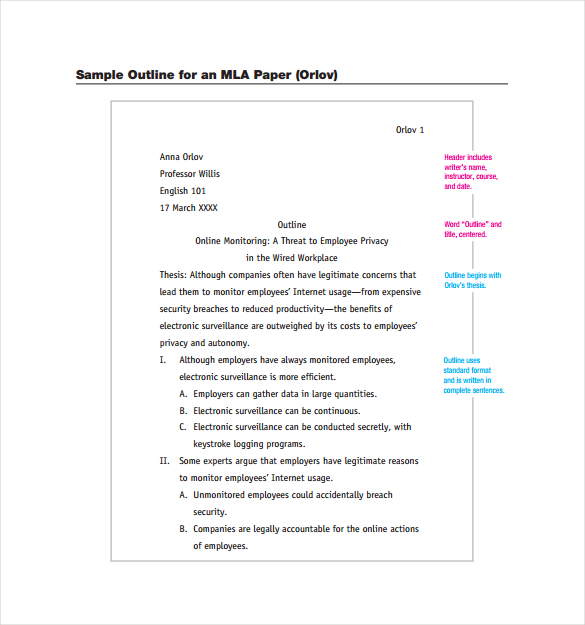
Designing one’s research paper has becoming very easy with the MLA outline paper template. Presenting one’s research in a readable and systematic format is the main use of an MLA outline paper template. It helps the writer collect his thoughts while writing and presenting them in a suitable format.
MLA Outline Template to Print
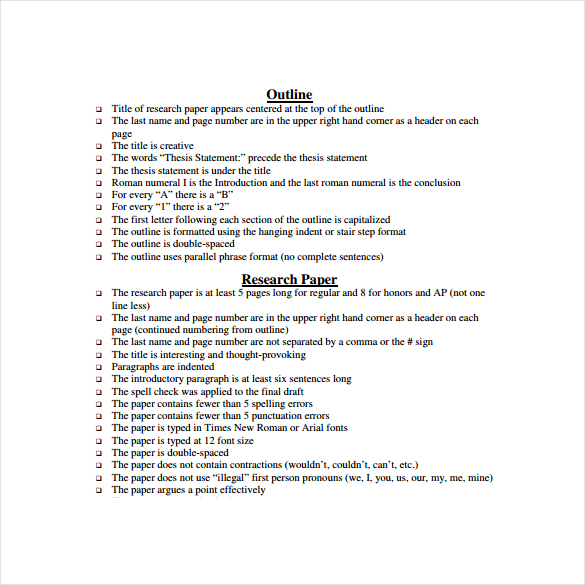
MLA Outline Format
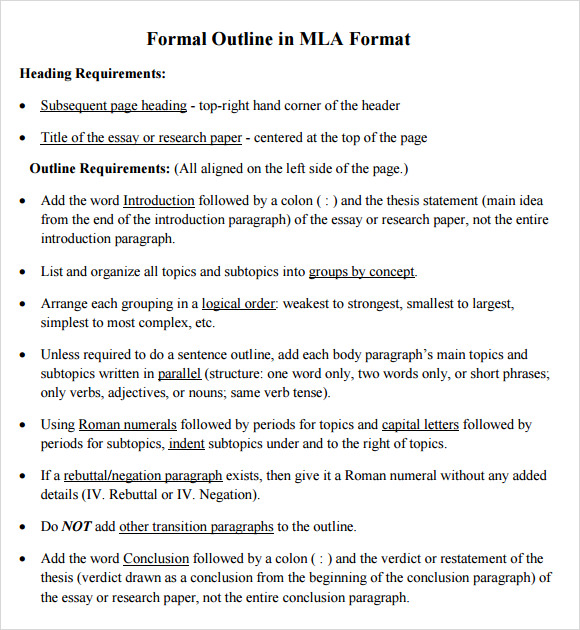
Uses of MLA Outline
An MLA outline is a structured format for organizing and sample planning a paper, typically used in the humanities, especially in English studies, language studies, and cultural studies. Here are eight uses of an MLA outline:
- Organize Thoughts and Research: An MLA outline helps you organize your ideas and research findings in a structured way, ensuring that all parts of your paper are logically arranged and that there is a cohesive flow from one section to another.
- Clarify Thesis Statement: By laying out main points and supporting details, an MLA outline clarifies how each section of the paper supports the thesis statement, making it easier to see the relationship between various arguments and evidence.
- Prevent Omission of Key Points: An outline ensures that all critical points are included in your paper. It acts as a sample checklist that you can refer to during the writing process to make sure no important details are left out.
- Enhance Flow of Paper: With a clear outline, transitions between paragraphs and sections become smoother, enhancing the overall flow of the paper. This organization helps readers understand the progression of your argument more clearly.
- Save Time: An outline can save time during the writing process by providing a clear roadmap of what to write about. This prevents time wasted on unnecessary digressions or on organizing thoughts during the actual writing phase.
- Facilitate Research: When you outline using MLA format, you can easily identify areas that require more research or more detailed evidence, allowing you to focus your research efforts more efficiently.
- Improve Presentation: A well-structured outline ensures that the final paper presents a professional appearance, which is critical in academic settings. It shows a clear organization of thought, which is often as important as the content itself.
- Ease of Revision: During revision, an outline makes it easier to see where changes need to be made without having to rewrite entire sections of the paper. You can adjust the outline itself before updating the paper, ensuring the edits are effective and efficient.
Creating an outline in MLA format is a critical step in the writing process, helping to make the drafting, revising, and finalizing of your paper more straightforward and effective. You may also see presentation outline templates
MLA Format Template
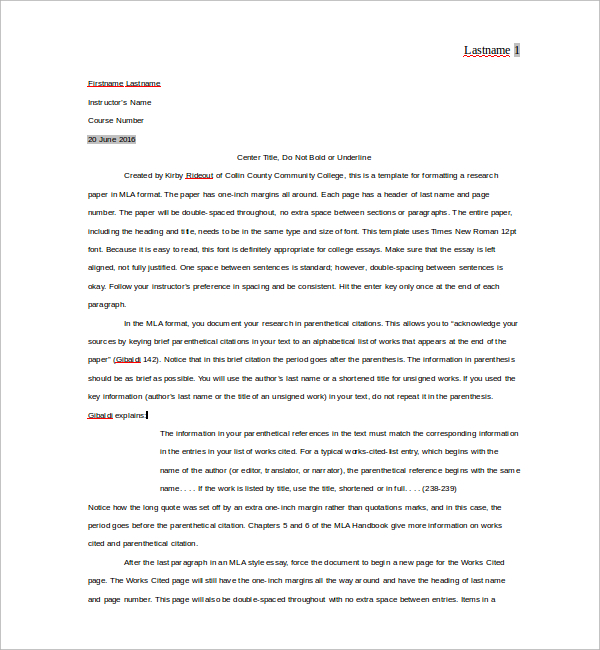
MLA Outline Example
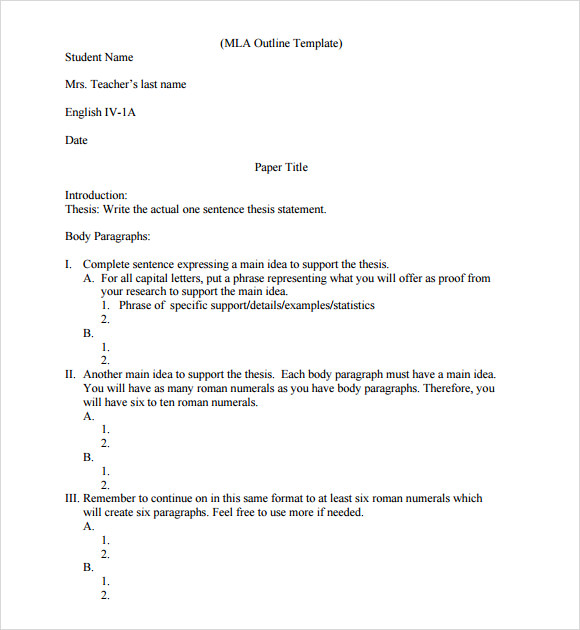
Benefits of MLA Outline

- Enhances Organization: An MLA outline helps structure your paper methodically, ensuring that all components fit together logically. This clarity aids both the writer and the reader in understanding the flow and progression of arguments.
- Streamlines Writing Process: With a clear outline, the writing process becomes more efficient. Knowing exactly what to write about in each section reduces the time spent on planning during the writing phase, allowing for a more focused approach to drafting. You can also see more on MLA Paper.
- Facilitates Research Focus: When you outline your paper, it becomes easier to identify which areas need more research. This helps in focusing your efforts on finding relevant information and evidence that supports your thesis and main points.
- Prevents Redundancy: An outline ensures that every piece of information has a purpose and a place in your argument, reducing repetition and unnecessary details. This makes your paper more concise and impactful.
- Improves Thesis Support: By visually mapping out your argument, an MLA outline allows you to see how each section contributes to supporting your thesis statement. This can lead to stronger, more persuasive arguments. You can also see more on MLA Format Essay.
- Aids in Smooth Transitions: A well-planned outline ensures that transitions between paragraphs and sections are seamless, which enhances the readability and flow of the paper, making it easier for readers to follow your line of reasoning.
- Reduces Risk of Straying Off Topic: With a detailed outline, you’re less likely to digress from the main topic. Each point and subpoint is deliberately placed to support the overarching thesis, keeping the paper on track.
- Simplifies Revisions: An outline makes it easier to revise and reorganize parts of the paper without extensive rewrites. Changes in the outline can guide substantial amendments in the draft efficiently, ensuring the final version meets all necessary criteria. You may also see speech outline samples
Thesis MlA Outline Template
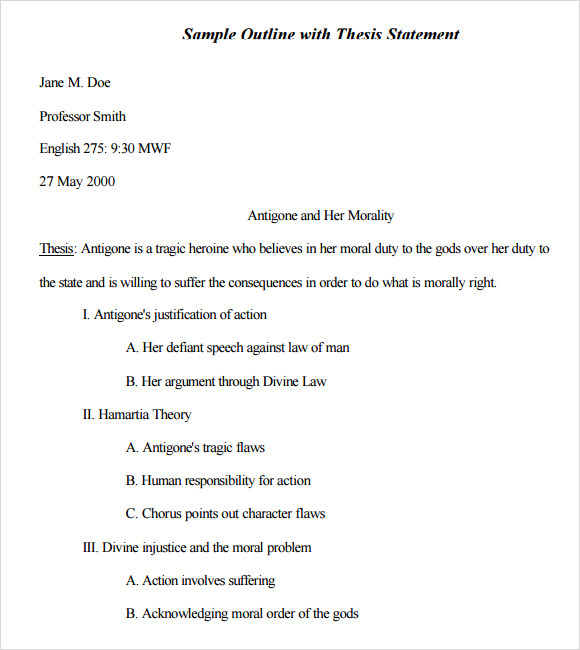
Sample PDF MLA Outline Template

Target Audience for MLA Outline Template
The target audience for MLA outline generator is the students of research, the scientists who wish to present their work in a readable format and the professionals who wish to write about their innovations. Apart from this, students also form the target audience for the MLA outline template. Even people in academia form the target audience for this template. In other words, all those who are doing academic writing in one form or the other form the target audience for this template. It is also widely used by writers in the field of academic writing. Therefore, academic writers also form its target audience. You may also see training outline templates.
How is MLA format organized?
MLA format is organized with 1-inch margins, double-spaced text, a header with page numbers, and uses a readable font like Times New Roman 12 pt. You can also see more on Research Paper Outline.
Is a MLA outline double-spaced?
Yes, an MLA outline is double-spaced, consistent with the formatting of the main text in an MLA-style document.
How to write a MLA format essay?
To write an MLA format essay, set 1-inch margins, use Times New Roman 12 pt font, double-space text, and include in-text citations and a Works Cited page. You can also see more on Mla Cover Page.
What are the 4 parts of MLA format?
The four parts of MLA format are: the header, in-text citations, Works Cited page, and general document formatting (font, margins, spacing).
Does MLA require a title page?
MLA format typically does not require a title page unless specified by the instructor; instead, a header on the first page includes necessary information. You can also see more on APA Research Paper Outline.
In conclusion, the MLA outline offers a structured framework that ensures clarity, coherence, and consistency in academic writing. By following its guidelines, writers can effectively organize their ideas, enhancing both readability and scholarly rigor.
If you have any DMCA issues on this post, please contact us!
Related Posts
7+ Presentation Outline Templates
6+ Sample Blank Outline Templates
21 Research Paper Outlines
15+ Essay Samples
12+ Essay Samples in PDF
10+ Sample High School Lesson Plans
9+ Sample Analysis Essays
8+ Sample Report Cover Pages
8 Amazing Training Outline Templates
7+ Informational Writing Samples
7+ Expository Writing Samples
6+ Chapter Summary Samples
Memo Format
9+ Essay Outline Samples
9+ Sample APA Outline Templates
